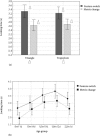Infants and toddlers show enlarged visual sensitivity to nonaccidental compared with metric shape changes
- PMID: 23145220
- PMCID: PMC3485767
- DOI: 10.1068/i0397
Infants and toddlers show enlarged visual sensitivity to nonaccidental compared with metric shape changes
Abstract
Some shape changes are more important for object perception than others. We used a habituation paradigm to measure visual sensitivity to a nonaccidental shape change-that is, the transformation of a trapezium into a triangle and vice versa-and a metric shape change-that is, changing the aspect ratio of the shapes. Our data show that an enhanced perceptual sensitivity to nonaccidental changes is already present in infancy and remains stable into toddlerhood. We have thus established an example of how early visual perception deviates from the null hypothesis of representing similarity as a function of physical overlap between shapes, and does so in agreement with more cognitive, categorical demands.
Keywords: development; habituation; looking time; preference; shape perception; shape transformations.
Figures


Similar articles
-
Sensitivity to Nonaccidental Configurations of Two-Line Stimuli.Iperception. 2017 Apr 3;8(2):2041669517699628. doi: 10.1177/2041669517699628. eCollection 2017 Mar-Apr. Iperception. 2017. PMID: 28491272 Free PMC article.
-
Representation of shape in individuals from a culture with minimal exposure to regular, simple artifacts: sensitivity to nonaccidental versus metric properties.Psychol Sci. 2009 Dec;20(12):1437-42. doi: 10.1111/j.1467-9280.2009.02465.x. Epub 2009 Oct 30. Psychol Sci. 2009. PMID: 19883490
-
Greater sensitivity to nonaccidental than metric shape properties in preschool children.Vision Res. 2014 Apr;97:83-8. doi: 10.1016/j.visres.2014.02.006. Epub 2014 Feb 28. Vision Res. 2014. PMID: 24582797
-
Subordinate-level object classification reexamined.Psychol Res. 1999;62(2-3):131-53. doi: 10.1007/s004260050047. Psychol Res. 1999. PMID: 10472199 Review.
-
The developmental origins of naïve psychology in infancy.Adv Child Dev Behav. 2009;37:55-104. doi: 10.1016/s0065-2407(09)03702-1. Adv Child Dev Behav. 2009. PMID: 19673160 Review.
Cited by
-
Towards a new kind of experimental psycho-aesthetics? Reflections on the Parallellepipeda project.Iperception. 2011;2(6):648-78. doi: 10.1068/i0464aap. Epub 2011 Oct 19. Iperception. 2011. PMID: 23145251 Free PMC article.
-
Development of differential sensitivity for shape changes resulting from linear and nonlinear planar transformations.Iperception. 2011;2(2):121-36. doi: 10.1068/i0407. Epub 2011 May 19. Iperception. 2011. PMID: 23145229 Free PMC article.
-
Deep Neural Networks as a Computational Model for Human Shape Sensitivity.PLoS Comput Biol. 2016 Apr 28;12(4):e1004896. doi: 10.1371/journal.pcbi.1004896. eCollection 2016 Apr. PLoS Comput Biol. 2016. PMID: 27124699 Free PMC article.
-
Sensitivity to Nonaccidental Configurations of Two-Line Stimuli.Iperception. 2017 Apr 3;8(2):2041669517699628. doi: 10.1177/2041669517699628. eCollection 2017 Mar-Apr. Iperception. 2017. PMID: 28491272 Free PMC article.
References
-
- Abecassis M, Sera M, Yonas A, Schwade J. “What's in a shape? Children represent shape variability differently than adults when naming objects”. Journal of Experimental Child Psychology. 2001;78:213–239. - PubMed
-
- Biederman I, Cooper E. “Size invariance in visual object priming”. Journal of Experimental Psychology Human Perception & Performance. 1992;18:121–133. doi: 10.1037/0096-1523.18.1.121. - DOI
LinkOut - more resources
Full Text Sources

